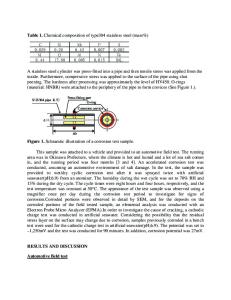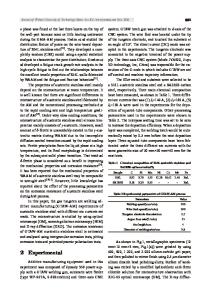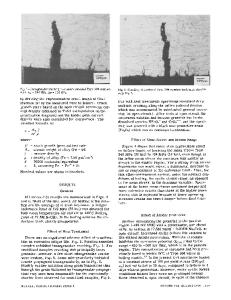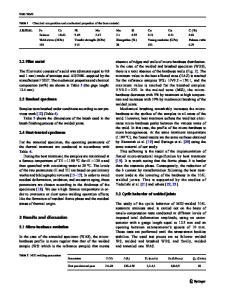Corrosion Behavior of Aqua-Blasted and Laser-Engraved Type 316L Stainless Steel
- PDF / 3,929,981 Bytes
- 15 Pages / 593.972 x 792 pts Page_size
- 33 Downloads / 282 Views
JMEPEG DOI: 10.1007/s11665-017-3053-4
Corrosion Behavior of Aqua-Blasted and Laser-Engraved Type 316L Stainless Steel B. Krawczyk, P. Cook, J. Hobbs, and D.L. Engelberg (Submitted July 16, 2017; in revised form September 24, 2017) The effect of aqua blasting and laser engraving on surface microstructure development, residual stress and corrosion resistance of type 316L stainless steel has been investigated. Aqua blasting resulted in a deformed near-surface microstructure containing compressive residual stresses. Subsequent laser engraving produced a surface layer with tensile residual stresses reaching to a depth of 200 microns. Changes of surface roughness topography were accompanied by the development of a thick oxide/hydroxide film after laser engraving. The atmospheric corrosion behavior of all surfaces with MgCl2-laden droplets was compared to their electrochemical response in 1M NaCl and 0.7 M HCl aqueous solutions. The measured total volume loss after atmospheric corrosion testing was similar for all investigated surface conditions. Laser-engraved surface exhibited the smallest number of corrosion sites, but the largest mean corrosion depth. Keywords
aqua blasting, atmospheric corrosion, austenitic stainless steel, laser engraving, oxide film, stress depth profiles
1. Introduction Thermo-mechanical processing via cold and hot rolling is typically used to control the bulk material properties of stainless steel, with coatings, surface blasting and peening, wire brushing and laser surface treatments applied to change the near-surface microstructure and its properties (Ref 1-3). To introduce compressive surface residual stresses, shot blasting, peening and brushing treatments are commonly applied. It is believed that compressive surface residual stresses increase the lifetime of components by inhibiting stress corrosion cracking (SCC), fatigue and corrosion fatigue (CF), whereas the presence of tensile residual surface stresses would lead to more vulnerable microstructures (Ref 4). The effect of surface peening and blasting treatments on the corrosion behavior are inconclusive, with reports suggesting an increased pitting corrosion resistance for blasted and peened surfaces (Ref 5), with other investigations indicating a reduction in the pitting potential, i.e., more susceptible microstructures (Ref 6). A reduction in the pitting corrosion resistance has been linked to the surface roughness finish, with the introduction of local micro-crevices, resulting in an increase in the passive current density, and far higher pit nucleation propensities (Ref 7-9). Laser engraving/marking and melting can be achieved by a variety of techniques, using SPI fiber and Nd:YAg lasers, affecting color patterns, microstructure, oxide development and corrosion performance (Ref 10-16). Lawrence et al. (Ref 11, 12) showed that the oxide thickness can be influenced by the B. Krawczyk and D.L. Engelberg, Corrosion and Protection Centre, School of Materials, The University of Manchester, Manchester M13 9PL, UK; and P. Cook and J. Hobbs, Sell
Data Loading...











